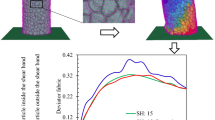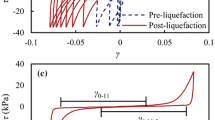Abstract
A comprehensive study on the meso-mechanical behaviors of sand with its 2D geometrical models was presented in this study. Based on the 2D geometrical models’ database of sand particles, quantitative analysis on the geometrical characteristics of the studied sand particles was performed A new clump generation algorithm based on fewer multiple overlapping circles was provided to accurately model the shape of sand particles, and was used to build the discrete element method (DEM) numerical model of the sand sample for DEM biaxial tests. The macro- and meso-mechanical behaviors of the studied sand samples were systematically analyzed. Deformation was mainly localized in a X-shaped shear zone, in which the particles experienced large displacements and rotations. Development of stress-induced anisotropy in particle and void orientations, as well as the mesoscopic fabric, was significant during the shearing process. Continuous collapse, generation, reduction, and extension of force chains occurred during the shearing process, especially after the peak stress was reached. This led to the fluctuations in the evolution of deviatoric stress and volumetric strain at macroscale, as well as the fabric anisotropy at mesoscale.
Similar content being viewed by others
References
Mirghasemi A A, Rothenburg L, Matyas E L. Influence of particle shape on engineering properties of assemblies of two-dimensional polygon-shaped particles. Géotechnique, 2012, 52: 209–217
Yan W M, Zhang L. Fabric and the critical state of idealized granular assemblages subject to biaxial shear. Comput Geotech, 2013, 49: 43–52
Cates M E, Wittmer J P, Bouchaud J P, et al. Jamming, force chains, and fragile matter. Phys Rev Lett, 1998, 81: 1841–1844
Bi D, Zhang J, Chakraborty B, et al. Jamming by shear. Nature, 2011, 480: 355–358
Yang H, Xu W J, Sun Q C, et al. Study on the meso-structure development in direct shear tests of a granular material. Powder Technol, 2017, 314: 129–139
Yang J, Wei L M. Collapse of loose sand with the addition of fines: The role of particle shape. Géotechnique, 2012, 62: 1111–1125
Xie Y H, Yang Z X, Barreto D, et al. The influence of particle geometry and the intermediate stress ratio on the shear behavior of granular materials. Granular Matter, 2017, 19: 35
Xiao Y, Long L, Matthew Evans T, et al. Effect of particle shape on stress-dilatancy responses of medium-dense sands. J Geotech Geoenviron Eng, 2019, 145: 04018105
Oda M, Kazama H, Konishi J. Effects of induced anisotropy on the development of shear bands in granular materials. Mech Mater, 1998, 28: 103–111
Luding S. Anisotropy in cohesive, frictional granular media. J Phys-Condens Matter, 2005, 17: S2623–S2640
Hosseininia E S. Investigating the micromechanical evolutions within inherently anisotropic granular materials using discrete element method. Granular Matter, 2007, 14: 483–503
Oda M, Koishikawa I, Higuchi T. Experimental study of anisotropic shear strength of sand by plane strain test. Soils Found, 1978, 18: 25–38
Lade P V, Nam J, Hong W P. Shear banding and cross-anisotropic behavior observed in laboratory sand tests with stress rotation. Can Geotech J, 2008, 45: 74–84
Rechenmacher A, Abedi S, Chupin O. Evolution of force chains in shear bands in sands. Géotechnique, 2010, 60: 343–351
Iwashita K, Oda M. Micro-deformation mechanism of shear banding process based on modified distinct element method. Powder Tech, 2000, 109: 192–205
Kuhn M R, Sun W C, Wang Q. Stress-induced anisotropy in granular materials: Fabric, stiffness, and permeability. Acta Geotech, 2015, 10: 399–419
Cundall P A, Strack O D L. A discrete numerical model for granular assemblies. Géotechnique, 1979, 29: 47–65
Kock I, Huhn K. Numerical investigation of localization and micromechanics in a stratified soil specimen. J Struct Geol, 2007, 29: 1679–1694
Garcia X, Latham J P, Xiang J, et al. A clustered overlapping sphere algorithm to represent real particles in discrete element modelling. Géotechnique, 2009, 59: 779–784
Rothenburg L, Bathurst R J. Influence of particle eccentricity on micromechanical behavior of granular materials. Mech Mater, 1993, 16: 141–152
Lin X, Ng T T. A three-dimensional discrete element model using arrays of ellipsoids. Géotechnique, 1997, 47: 319–329
Munjiza A, Peters J F, Hopkins M A, et al. A poly-ellipsoid particle for non-spherical discrete element method. Eng Computation, 2009, 26: 645–657
Thomas P A, Bray J D. Capturing nonspherical shape of granular media with disk clusters. J Geotech Geoenviron Eng, 1999, 125: 169–178
Yang Z X, Yang J, Wang L Z. Micro-scale modeling of anisotropy effects on undrained behavior ofgranular soils. Granular Matter, 2013, 15: 557–572
Li C Q, Xu W J, Meng Q S. Multi-sphere approximation of real particles for DEM simulation based on a modified greedy heuristic algorithm. Powder Technol, 2015, 286: 478–487
Jiang M D, Yang Z X, Barreto D, et al. The influence of particle-size distribution on critical state behavior of spherical and non-spherical particle assemblies. Granular Matter, 2018, 20: 80
Govender N, Wilke D N, Kok S. Collision detection of convex polyhedra on the NVIDIA GPU architecture for the discrete element method. Appl Math Comput, 2015, 267: 810–829
Ting J M, Khwaja M, Meachum L R, et al. An ellipse-based discrete element model for granular materials. Int J Numer Anal Methods Geomech, 1993, 17: 603–623
Barrett P J. The shape of rock particles, a critical review. Sedimentology, 1980, 27: 291–303
Blott S J, Pye K. Particle shape: A review and new methods of characterization and classification. Sedimentology, 2007, 0: 31–63
Masad E, Button J W. Unified imaging approach for measuring aggregate angularity and texture. Comp-Aided Civil Eng, 2000, 15: 273–280
Bowman E T, Soga K, Drummond W. Particle shape characterisation using Fourier descriptor analysis. Géotechnique, 2001, 51: 545–554
Wettimuny R, Penumadu D. Application of fourier analysis to digital imaging for particle shape analysis. J Comput Civil Eng, 2004, 18: 2–9
Chandan C, Sivakumar K, Masad E, et al. Application of imaging techniques to geometry analysis ofaggregate particles. J Comput Civil Eng, 2004, 18: 75–82
Wang L, Wang X, Mohammad L, et al. Unified method to quantify aggregate shape angularity and texture using Fourier analysis. J Mater Civ Eng, 2005, 17: 498–504
Zheng J, Hryciw R D. Traditional soil particle sphericity, roundness and surface roughness by computational geometry. Géotechnique, 2015, 65: 494–506
Kozicki J, Donzé F V. A new open-source software developed for numerical simulations using discrete modeling methods. Comput Methods Appl Mech Eng, 2008, 197: 4429–4443
Kozicki J, Donzé F V. YADE-OPEN DEM: An open-source software using a discrete element method to simulate granular material. Eng Computation, 2009, 26: 786–805
Huang Z, Yang Z, Wang Z. Discrete element modeling of sand behavior in a biaxial shear test. J Zhejiang Univ Sci A, 2008, 9: 1176–1183
Kang D H, Yun T S, Lau Y M, et al. DEM simulation on soil creep and associated evolution of pore characteristics. Comput Geotech, 2012, 39: 98–106
Xu W J, Hu L M, Gao W. Random generation of the meso-structure of a soil-rock mixture and its application in the study of the mechanical behavior in a landslide dam. IntJ Rock Mech Min Sci, 2016, 86: 166–178
Yang Z X, Li X S, Yang J. Quantifying and modelling fabric anisotropy of granular soils. Géotechnique, 2008, 58: 237–248
Oda M, Nemat-nasser S, Konishi J. Stress-induced anisotropy in granular masses. Soils Found, 1985, 25: 85–97
Rothenburg L, Bathurst R J. Analytical study ofinduced anisotropy in idealized granular materials. Géotechnique, 1989, 39: 601–614
Bathurst R J, Rothenburg L. Observations on stress-force-fabric relationships in idealized granular materials. Mech Mater, 1990, 9: 65–80
Author information
Authors and Affiliations
Corresponding author
Additional information
This work was supported by the National Key Research and Development Program during the 13th Five-Year Plan of China (Grant No. 2017YFC0805406), and the National Natural Science Foundation of China (Grant Nos. 51879142, 51679123 & 51479095).
Rights and permissions
About this article
Cite this article
Xu, W., Feng, Z., Yang, H. et al. Study on meso-mechanical behavior of sand based on its 2D geometrical model. Sci. China Technol. Sci. 63, 777–790 (2020). https://doi.org/10.1007/s11431-019-9598-2
Received:
Accepted:
Published:
Issue Date:
DOI: https://doi.org/10.1007/s11431-019-9598-2




